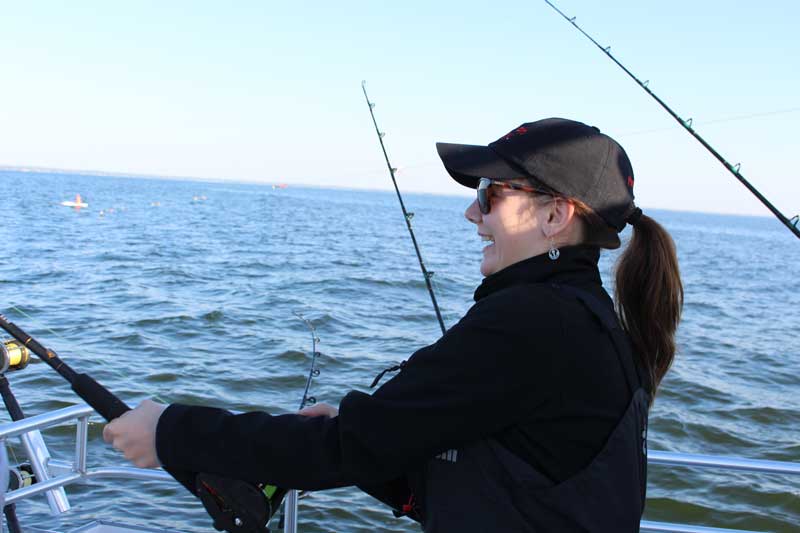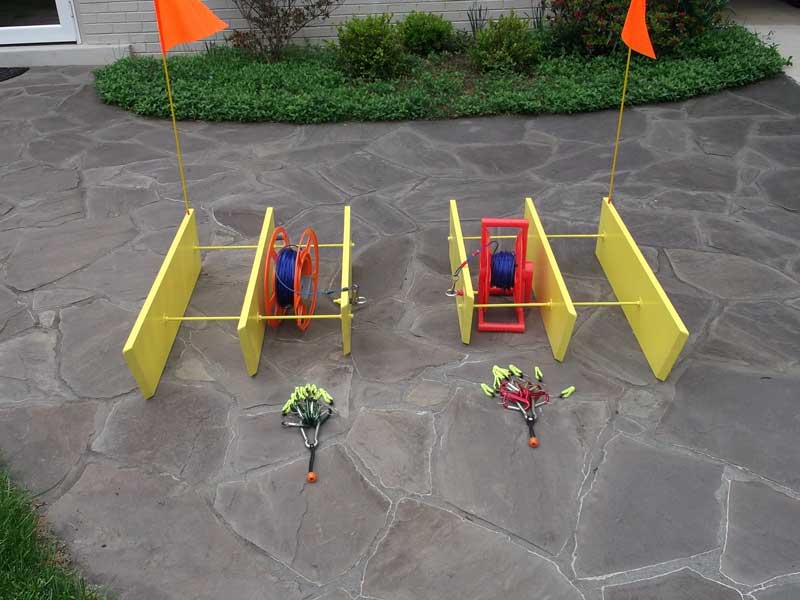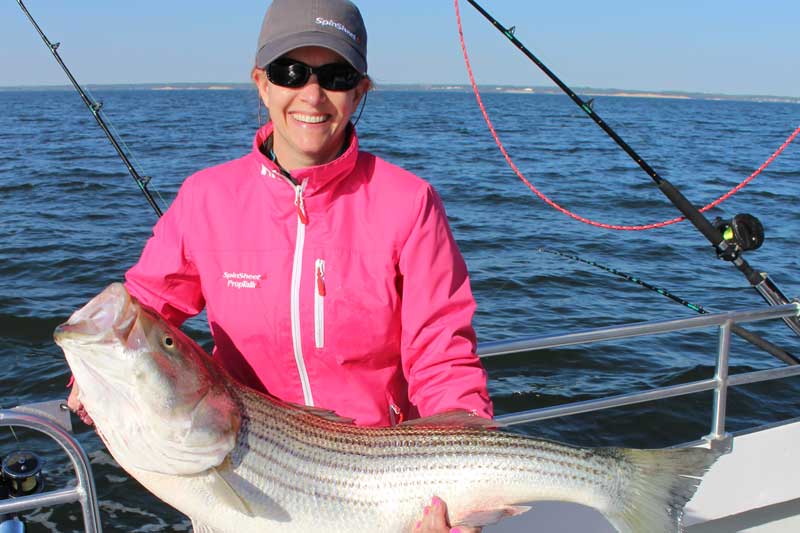As satisfying as setting your own favorite spring trophy striper trolling spreads and trolling with planer boards on your personal boat can be, a trip aboard a charter can be a welcome break. Someone else does most of the preparing, hauling, launching, rigging, navigating, and so forth. Meanwhile, you can do all the learning. That was our goal when we jumped aboard the Ebb Tide, to shoot this video on how to troll with planer boards.
Pulling planers is in some ways more commercial than recreational. As you saw in the video, using them means it’s time to go to work, and often, time to play Bay Chicken.

The use of planer boards is trolling on steroids. One boat pulling a wide wall of lures covers the same lateral and water column space as three or four traditional trollers working side-by-side. On top of that, planer boards need continuous monitoring and frequent tending. Fishing lines must be reset after false or short strikes, and cleared or cleaned when end tackle becomes fouled. When the bite is on, setting the hook, clearing other lines, and hauling in and netting fish add to the workload. All this activity is complicated by limited cockpit space on a boat. Working a crossing fish through the maze to avoid basket-weaving lines together adds to the challenge.
Planer tending is not on my bucket list, so it didn’t bother me when my fishing partner left his triple boards at home before we departed on one of recent our Bay excursions. The wind was already blowing when we left Northern Virginia, portending difficult conditions for deploying planers from a small boat. After we got on the water, conditions were too choppy for jigging without getting beat up. So, we put out a traditional trolling spread of five lines. There were lots of small whitecaps hiding any breaking fish. No working birds were in sight, but trollers with planer boards were out in force. I lounged on the fish box facing aft, watched the lines, took senior catnaps, and looked around just in case there were any birds or breaking fish. Rocking and rolling was having its usual soothing effect on the old salt who dozed off. All was happy and good. Then, things went wrong quickly.
A big wave jostled me into semi-consciousness. A recreational boat passing down the port side came into my peripheral vision. Our separation was okay for traditional trolling spreads, about 40 yards or so. Folks aboard the other boat were acting casually, no obvious looks of concern or frantically waving arms. But something just didn’t feel right. Too many poles were up. If they had planer boards were out, we were too close
Turning to look forward, I saw my partner diligently scanning ahead. No boards were visible. Then, a small dark log appeared off the starboard bow surfing down a white cap. Oh no! It was an unpainted planer board without a flag on a clear mono cord – and we were 25 yards inboard. We were, using Rules of the Road lingo, “in extremis.” An emergency turn and a power surge brought us outboard, where we then killed all headway to allow our lines to drop down towards the bottom. Fortunately, the board and fishing lines cleared without mishap. There were no fouled lines, no tangled mess to cut away, and no unpleasant gear disputes. International orange or bright yellow boards with orange or yellow pennants and a brightly colored cord rather than clear monofilament would have been very helpful, and would have allowed us to avoid this unexpected game of chicken.

Back when it was mostly just charterboats pulling planers, there was still room to fish around them. But today, similar setups are common on large boats and even some of the smaller ones. With more and more recreational boats deploying planer boards in recent years, water space has become much tighter during trophy season. The potential for gear conflicts has increased.
Spread widths have also grown. In some cases, they are extreme. Thirty to 50 yards of board line for recreational boats and 50 yards for charterboats are common. Longer lengths are not uncommon for charterboats, and for recreational boats whose operators have “gone commercial.” I’ve seen some spreads that must be a good 75 to 100 yards out from each side. With swaths like these, the area occupied by a trolling fleet often congests quickly, especially on weekends, holidays, and during tournaments. Even when you don’t have boards of your own deployed, finding a hole to troll between multiple planer boarders running in different directions is like running a constantly changing slalom course.
One must be ever mindful that damage or injury could be severe were a boat swept under a planer board cord. The danger is especially extreme for low open boats. Getting whacked by a cord could easily knock a person overboard, or worse. If a cord were to snag on a deck fitting, trolling motor, or something else, a boat could be pulled over and swamp or capsize. Running overtop the cord and snagging it with the outboard or other protrusions from the hull runs the risk of getting pulled backwards and underwater.

So, when it’s just too crazy out there to operate without being in a continual high state of agitation, knowledge of sunken bridges, other natural and artificial reefs, wrecks, and obstructions as alternative places to fish, is a good thing.
This article is a partial chapter excerpt from “Bridges Under Troubled Waters: Upper Chesapeake and Tidal Potomac Fishing Reefs,” reprinted with the permission of author Wayne Young. Young is a former manager of the Maryland artificial reef program for Bay waters and his new book describes artificial reefs, oyster bars, rocks, ruins, wrecks, and obstructions in the Maryland portions of the Chesapeake Bay and tidal Potomac River, as well as where and how to find them. We read it, and found gobs of very cool info for anglers. “Bridges Under Troubled Waters: Upper Chesapeake and Tidal Potomac Fishing Reefs” can be purchased at Amazon.
Bay Chicken Take-Aways
- When in a randomly maneuvering trolling fleet, the general prudential rules of seamanship apply. Take early precautionary to avoid getting your boat into a situation that makes emergency maneuvering necessary.
- Planer spread widths aren’t regulated, so a little common sense is in order – do you really need lines any longer than 150 feet? Probably not. In fact, some sharpies feel the effectiveness of planer board lines dwindles when they’re longer, theory being that the fish swim off to the sides when a boat passes overhead and thus see your board line offerings – but they don’t swim that far off.
- Use high-visibility colors for your boards, board lines, and flags. You say your planer boards don’t have flags? That’s part of the problem, and should be remedied ASAP. If you tangle with someone while pulling dark boards and/or with no flags, it’s pretty obvious where the blame lays.
- Avoid abrupt course changes that suddenly turn the established course of another boat into a potential game of chicken (in other words, don’t turn right in front of someone else when you know you’ll be forcing them to turn off).
- Keep a sharp eye on where your boards are in relation to other boats. In the example Young gives in this article, the captain and occupants of the other boat didn’t even realize their board was about to pass on the far side of another boat.
And above all folks, when a gear conflict does occur, calm your temper and keep things friendly. Getting into a shouting match as you cut lines and unwind tangles won’t accomplish anything beyond raising everyone’s blood pressure.